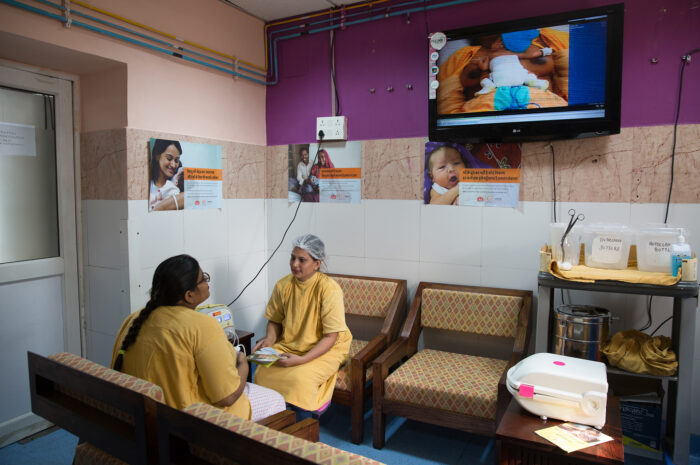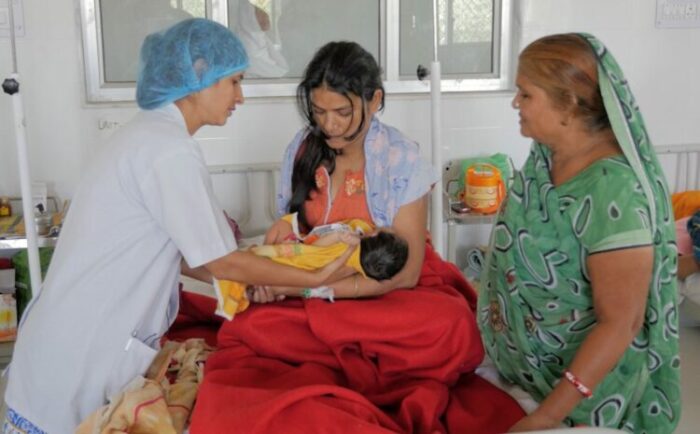Optimizing care for the small and sick newborn requires prioritizing their mother: Why early, specialized lactation support is vital for long-term feeding success

When putting baby to the breast is not possible
We’ve all heard that “breastfeeding is best!” and “put baby to breast within the first golden hour.” While these messages are important for all babies, they are missing the mark for small and/or sick newborns (SSN) who may not be physically able to feed directly at the breast.
Nearly 1 in 10 newborns are born too soon – that is 1 out of every 10 births that are most likely to require unique lactation care due to challenges with baby not feeding directly at the breast. WHO recommends mothers’ own milk as the first option for this vulnerable population, but current systems for providing lactation care require a transformation to a comprehensive vision and care platform that places mothers’ unique lactation needs at the center – as the driver of the first food system and foundation for long-term infant feeding and health outcomes.
What would it take for our systems of care to pivot when standard breastfeeding messaging – to put the baby to the breast in the first few hours, days, or weeks – is not feasible? What is the “secret sauce” that ensures early and long-term nutrition needs are met, starting from those first critical hours after birth, for the small and/or sick newborn?
For these babies and for these mothers, the first hours and days of life set a trajectory for success of producing and maintaining an adequate milk supply and feeding at the breast weeks and months later. To meet the mark, we need ultimately to align maternal care with neonatal care, to meet early and long-term feeding needs.
For newborns, this means we need to provide their mothers’ expressed colostrum within the first hours of life or as soon as possible, and when a mother’s own milk can not be given and a human milk bank is available, providing safe donor human milk from a human milk bank as a bridge until their mothers’ milk is fully meeting their needs, thus protecting an exclusive human milk diet. For their mothers, this means we need to provide specialized lactation support and the accompanying necessary supplies to initiate, build, store and maintain a robust milk supply via milk expression to feed their babies – not only in the hospital, but for a long time. For both the mother and newborn, this means breaking down the journey to direct breastfeeding into tangible steps for long-term feeding success.
The challenges are complex, yet manageable
Numerous challenges exist that require understanding of the unique situation these mothers and babies face. Some challenges are physiological; preterm and vulnerable newborns require higher nutritional needs from the first few days of life because their time to receive further nutrition in-utero was cut short. Mothers are able to provide their colostrum early; however, waiting for their copious milk supply takes time to ‘come in’ (also called secretory activation), time that preterm infants do not always have. For mothers of terms infants, copious milk supply typically develops around day three after birth, however due to the stress of preterm birth, or any maternal health complications and/or not being able to express milk, reaching secretory activation is often delayed beyond the period the preterm infant can wait. The misalignment of reaching secretory activation while the small and/or sick newborn requires immediate nutrition is a major concern and requires both strong early lactation to prevent delays in milk coming in as well as provision of safe alternatives, such as donor human milk, to bridge this period.
Additional challenges are at the systems-level. A primary example is mother-baby separation; for critical-care newborns, they are often taken immediately to the neonate ward for intensive care, while the mother remains in the maternity ward for hours, sometimes waiting days before seeing her newborn. Separation disrupts the crucial potential for mother to directly feed her expressed milk or to even allow the baby to practice suckling at the breast as they are ready.
Additionally, when separation is within a hospital, mechanisms for ensuring that mothers’ expressed milk reaches their infants are often lacking – even if the mother is simply in another ward, or down the hall. Systems frequently rely on mothers’ physical presence to provide her milk during limited visiting hours (in many settings this can be 15 minutes every three hours), or rely on another family member to transport the expressed milk from the postpartum ward to the newborn unit.
The complexity of supporting mothers’ unique lactation needs to feed their admitted newborns requires multidisciplinary teams with strong coordination, supplies management, and enhanced lactation counseling skills. Yet because systems for maternal, newborn, and nutrition care are repeatedly siloed – at global, regional, and facility levels – insufficient lactation support for the most vulnerable populations remains hidden and forgotten. While this seems complex there are straightforward steps facilities and Ministries of Health can take to meet these needs.
The “secret sauce” – transforming systems to support small and/or sick newborns and their mothers for long-term feeding success
Three key ingredients make up the “secret sauce” for meeting the unique lactation and nutrition needs of small and/or sick newborns and their mothers: 1) enhanced staff training and competencies specializing in the specialized lactation needs of this population, 2) strengthened systems for enabling an environment supportive of lactation and human milk services, and 3) improved milk expression supplies.
1. Enhanced training: The workforce
- Train all health care workers (inpatient and in the community) providing care to mothers and newborns on skills and competencies for providing improved counseling and support for early and frequent milk expression for building a robust milk supply when baby cannot feed at the breast and support for the mother and newborn on the journey to at-the-breast feeding
- Maternity ward staff train mothers to initiate milk expression as early as possible, not waiting until she physically reaches the newborn unit
- Health care workers counsel mom and baby with hands-on support for milk expression, getting baby back to breast
2. Improved services: The strengthened system
- Align across maternal, newborn, and nutrition care, policies, programming and leadership at all system levels
- Until the issue of separation is solved through improved immediate kangaroo mother care (iKMC), set up systems to account for and transport mom’s milk to her infant
- Integrate human milk banks to provide safe donor human milk as a bridge to mothers’ own milk, a physical location for lactation support, and an opportunity to use excess expressed milk that would be otherwise wasted or disposed
- Create spaces that support zero separation or more frequent and ease of visitation and involvement in care
- Ensure discharge criteria include transitioning back to the breast and feeding plan
- Ensure follow-up care is established to provide ongoing lactation and feeding evaluation, counseling and support
- Integrate services with enhanced maternal mental health, nutrition care, and iKMC to build an enabling environment for strong lactation care
3. Improved availability of milk expression supplies and devices
- Provide supplies and devices to support milk expression, storage, and feeding, especially for the mothers of newborns unable to feed directly at the breast
- Create sanitation and hygiene stations, or facility-supported cleaning and sterilization for all milk expression and feeding supplies to ensure safety
- Consider options for safe storage and transportation that maintain the cold-chain for expressed and donated milk
Paving a way forward toward linkages for optimal maternal lactation
With the increased momentum for caring for small and/or sick newborns, it’s time to redesign systems to account for the lactation needs of mothers and support early and frequent feeding of mom’s own milk, with accessible donor milk as needed. True transformation, aligning with the needs of mothers at the center of care, is essential for linking core agendas of newborn health, maternal health, and nutritional care.






